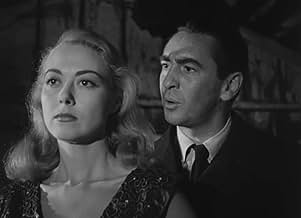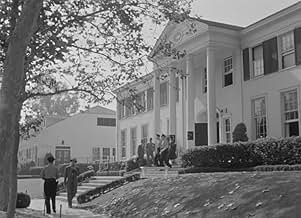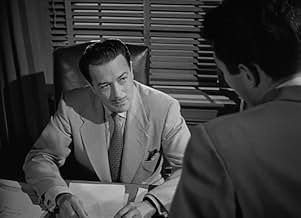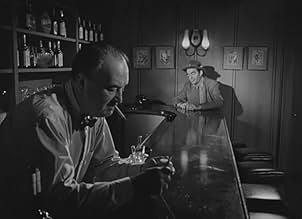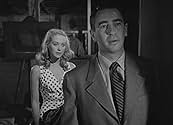अपनी भाषा में प्लॉट जोड़ेंLawyer defends migrant worker falsely accused of two murders.Lawyer defends migrant worker falsely accused of two murders.Lawyer defends migrant worker falsely accused of two murders.
Frank Baker
- Court Stenographer
- (बिना क्रेडिट के)
Marshall Bradford
- Coroner
- (बिना क्रेडिट के)
Ralph Brooks
- Courtroom Photographer
- (बिना क्रेडिट के)
Benny Burt
- Citizen
- (बिना क्रेडिट के)
Jack Carr
- Angry Citizen
- (बिना क्रेडिट के)
Robert Carson
- Jury Foreman
- (बिना क्रेडिट के)
Ralph Dumke
- Bartender
- (बिना क्रेडिट के)
Richard Emory
- Reporter
- (बिना क्रेडिट के)
फ़ीचर्ड समीक्षाएं
MacDonald Carey and Teresa Wright, both of whom starred in Hitchcock's Shadow of a Doubt, work together again in a less prestigious film, "Count the Hours" from 1953, directed by Don Siegel.
Wright is Ellen Braden, whose husband George (John Craven), a migrant worker, is arrested for the murder of an elderly man and his housekeeper that was done apparently during a robbery - the man kept a lot of money in his house.
When asked if he has a gun, he at first says no. His wife runs home and throws the gun in the lake, but she's seen doing it. By then he's admitted to having one. He's believed to be guilty.
Carey plays attorney Doug Madison, who is asked to take the case but refuses. After speaking with Mrs. Braden, he changes his mind. He's convinced that they have to find the gun. But when they do, it's a disappointment. Doug believes in George's innocence, which means they have to find the killer.
Pretty good mystery-suspense film which also features Jack Elam. Wright is sympathetic as the pregnant Ellen who believes in her husband, but John Craven doesn't register much.
Carey was an affable leading man who found his great success on Days of Our Lives. He had a wonderful speaking voice and a gentle presence. Elam is his usual evil-looking and sleazy self.
On the ordinary side but tense nonetheless.
Wright is Ellen Braden, whose husband George (John Craven), a migrant worker, is arrested for the murder of an elderly man and his housekeeper that was done apparently during a robbery - the man kept a lot of money in his house.
When asked if he has a gun, he at first says no. His wife runs home and throws the gun in the lake, but she's seen doing it. By then he's admitted to having one. He's believed to be guilty.
Carey plays attorney Doug Madison, who is asked to take the case but refuses. After speaking with Mrs. Braden, he changes his mind. He's convinced that they have to find the gun. But when they do, it's a disappointment. Doug believes in George's innocence, which means they have to find the killer.
Pretty good mystery-suspense film which also features Jack Elam. Wright is sympathetic as the pregnant Ellen who believes in her husband, but John Craven doesn't register much.
Carey was an affable leading man who found his great success on Days of Our Lives. He had a wonderful speaking voice and a gentle presence. Elam is his usual evil-looking and sleazy self.
On the ordinary side but tense nonetheless.
A lawyer defends a migrant worker falsely accused of two murders.
What is interesting, first of all, is how the defendant is described as a "migrant worker". That is not incorrect, but I think perhaps the connotation in 1953 is different than in 2017, because now the term would almost exclusively be referring to a Latino employee. In fact, the United Nations defines a migrant worker as "a person who is engaged or has been engaged in a remunerated activity in a State of which he or she is not a national." This, more often than not, would be Mexican farmhands in the case of the United States.
Anyway, the film is quite good. I don't know if it was a feature or a B-movie, as it does give the impression of not having big names attached and perhaps a smaller budget. But for entertainment purposes and a but of suspense, it does the job. In retrospect, it also serves as a great example of early work from director Don Siegel.
What is interesting, first of all, is how the defendant is described as a "migrant worker". That is not incorrect, but I think perhaps the connotation in 1953 is different than in 2017, because now the term would almost exclusively be referring to a Latino employee. In fact, the United Nations defines a migrant worker as "a person who is engaged or has been engaged in a remunerated activity in a State of which he or she is not a national." This, more often than not, would be Mexican farmhands in the case of the United States.
Anyway, the film is quite good. I don't know if it was a feature or a B-movie, as it does give the impression of not having big names attached and perhaps a smaller budget. But for entertainment purposes and a but of suspense, it does the job. In retrospect, it also serves as a great example of early work from director Don Siegel.
Count the Hours (AKA: Every Minute Counts) is directed by Don Siegel and written by Karen DeWolf and Doane R. Hoag. It stars Macdonald Carey, Teresa Wright, John Craven, Jack Elam, Dolores Moran, Adele Mara and Edgar Barrier. Music is by Louis Forbes and cinematography by John Alton.
When a farmer and his housekeeper are murdered, suspicion falls on the hired hand George Braden (Craven). Owning a gun that matches the bullets used in the killings, Braden and his wife Ellen (Wright) are taken in for questioning when Ellen panics and is seen to throw the weapon into a lake. Under pressure and wanting to free his wife from duress, Braden confesses to the crime and finds himself on trial for his life. Enter Doug Maddison (Carey), a local lawyer who comes to believe that Braden is innocent and faces a fight against the clock to save Braden from the hangman's noose.
The pairing of Don Siegel and John Alton alerts the noir crowd to this compact low budget race against the clock thriller. In truth it's standard fare on a plot basis, with a mixed bag of acting performances (Elam and Wright exempt) and poor use of the Theramin in the musical score (it telegraphs what we should expect and feels on this occasion it's in the wrong movie), but within simplicity of story also comes potent points of worth.
As the clock ticks down and the stakes are raised, Siegel and the writers slot in the distasteful workings of the human being. Not only is there the running theme of the law quite frankly being an ass, but there is the bite of the rumour mill, a man forcing himself on to a desperate woman (Siegel zooms in for an emphasised facial shot that is bone chilling) and psychiatry playing a judicial hand; and not a good one at that!
Then there is Alton bringing his photographic tricks to compliment Siegel's efforts to lift a standard screenplay to greater things. Angular shots feature but it's with shadows and light that Alton excels, none more so than with the prison sequences. Here is where a frantic Braden is being held and it is a caged hell, because Alton highlights the shadows from the bars on the doors and windows as well, there is no escape from bars, they literally are all around, with one shot showing Alton at his best.
It's little seen and most likely forgotten about, and certainly its qualities have been ignored by the none film noir loving crowd, yet this is well worth a peek for those film lovers who like trawling the back alleyways for Siegel and Alton peccadilloes. 7.5/10
When a farmer and his housekeeper are murdered, suspicion falls on the hired hand George Braden (Craven). Owning a gun that matches the bullets used in the killings, Braden and his wife Ellen (Wright) are taken in for questioning when Ellen panics and is seen to throw the weapon into a lake. Under pressure and wanting to free his wife from duress, Braden confesses to the crime and finds himself on trial for his life. Enter Doug Maddison (Carey), a local lawyer who comes to believe that Braden is innocent and faces a fight against the clock to save Braden from the hangman's noose.
The pairing of Don Siegel and John Alton alerts the noir crowd to this compact low budget race against the clock thriller. In truth it's standard fare on a plot basis, with a mixed bag of acting performances (Elam and Wright exempt) and poor use of the Theramin in the musical score (it telegraphs what we should expect and feels on this occasion it's in the wrong movie), but within simplicity of story also comes potent points of worth.
As the clock ticks down and the stakes are raised, Siegel and the writers slot in the distasteful workings of the human being. Not only is there the running theme of the law quite frankly being an ass, but there is the bite of the rumour mill, a man forcing himself on to a desperate woman (Siegel zooms in for an emphasised facial shot that is bone chilling) and psychiatry playing a judicial hand; and not a good one at that!
Then there is Alton bringing his photographic tricks to compliment Siegel's efforts to lift a standard screenplay to greater things. Angular shots feature but it's with shadows and light that Alton excels, none more so than with the prison sequences. Here is where a frantic Braden is being held and it is a caged hell, because Alton highlights the shadows from the bars on the doors and windows as well, there is no escape from bars, they literally are all around, with one shot showing Alton at his best.
It's little seen and most likely forgotten about, and certainly its qualities have been ignored by the none film noir loving crowd, yet this is well worth a peek for those film lovers who like trawling the back alleyways for Siegel and Alton peccadilloes. 7.5/10
The great director who would make " invasion of the body snatchers" "the killers" "the beguiled" and even Elvis' best ("flaming star") is already present;his flair for film noir and for disturbing atmosphere is glaring in the scene in which the diver tries to rape T. Wright:the way Siegel films his eyes is absolutely terrifying ;ditto for the scenes when the lawyer looks for the former employee;oddly Siegel does not seem to very interested in T.Wright's character and the last scenes are given over to Dolores Moran and Adele Mara,who are relatively obscured thespians compared to the star of "shadow a doubt" and Wyler's war movies.
However,the movie is absorbing and a must for suspense buffs.
Like this ?try these
"phantom lady" (Robert Siodmak,1944)
"time without pity" (Joseph Losey ,1956)
"they won't forget " (Mervyn LeRoy,1937)
However,the movie is absorbing and a must for suspense buffs.
Like this ?try these
"phantom lady" (Robert Siodmak,1944)
"time without pity" (Joseph Losey ,1956)
"they won't forget " (Mervyn LeRoy,1937)
Surprisingly interesting story for a B picture from the early fifties - this could have been made as a major feature if it was given a bigger budget and a director worthy of its plot developments. Sincere performances by Teresa Wright and McDonald Cary are well above the average but director Don Siegel is just not the right man for the job. The story by Doane Hoag has all the right twists and turns and holds the interest but needed more attention to detail and less clichéd handling. The music score was certainly different but seemed to have been lifted from a Si-Fi -'body snatcher' type movie.
If looking for a 50s time passer (with undeveloped possibilities) this is still worth a look. Prolific and inventive Award winning Hungarian cinematographer John Alton shows terrific flair for B/W photography and lighting - lifting this little crime meller to above average standards. The ending is typical of the era - but, still better than many other average B pictures.
If looking for a 50s time passer (with undeveloped possibilities) this is still worth a look. Prolific and inventive Award winning Hungarian cinematographer John Alton shows terrific flair for B/W photography and lighting - lifting this little crime meller to above average standards. The ending is typical of the era - but, still better than many other average B pictures.
क्या आपको पता है
- ट्रिवियाAfter Director of Photography John Alton agreed to shoot this movie, he asked Producer Benedict Bogeaus how much he had budgeted for rigging - the system of overhead pipes, brackets, ropes, and cables that suspend lights over a film set. Bogeaus told him four thousand dollars. "Give me two thousand dollars above my salary and I won't use any rigging," said Alton. He did it by using almost no overhead lighting at all, contributing to the film's rich visual atmosphere.
- गूफ़The screen shows a newspaper article stating that George Braden is about to go on trial for the murder of Fred Morgan. However, two people were killed, so both names should have been given.
- कनेक्शनReferenced in Mau Mau Sex Sex (2001)
टॉप पसंद
रेटिंग देने के लिए साइन-इन करें और वैयक्तिकृत सुझावों के लिए वॉचलिस्ट करें
विवरण
- चलने की अवधि1 घंटा 16 मिनट
- रंग
- पक्ष अनुपात
- 1.37 : 1
इस पेज में योगदान दें
किसी बदलाव का सुझाव दें या अनुपलब्ध कॉन्टेंट जोड़ें


